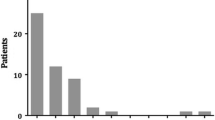Abstract
Background
Endoscopic sphincterotomy (EST) with stone extraction is the standard management for choledocholithiasis. However, the necessity for subsequent management of gallstone to prevent the biliary complications remained controversial and few data were evaluated for the impact of status of gallbladder on recurrent biliary complications. We retrospectively investigated the relationship between the status of gallbladder and the occurrence of biliary complications after endoscopic removal of choledocholithiasis.
Methods
Between January 1998 and December 2008, we enrolled 453 patients with intact gallbladder who underwent EST for choledocholithiasis and allocated into two groups: calculous gallbladder (n = 256) and acalculous gallbladder (n = 197). By reviewing patients’ medical records, we compared the occurrence of biliary complications according to the presence or absence of gallstone in GB in situ.
Results
In total, biliary complications occurred in 83 patients (18.3 %) during the follow-up period. Calculous GB group had higher rate of overall complications (22.7 vs. 12.7 %; p = 0.007) and GB-associated complications (11.3 vs. 2.5 %; p = 0.001) than acalculous GB group. On the multivariate analysis, only the presence of gallstone was shown to be significant risk factor for overall biliary complication (OR 2.029; 95 % CI 1.209–3.405; p = 0.007) and GB-associated complications (OR 5.077; 95 % CI 1.917–13.446; p = 0.001). Mean event-free period was shorter in calculous GB group than acalculous GB group for overall complications (1774 vs. 2159 days; p = 0.012) and GB-associated complication (2153 vs. 2591 days; p = 0.001).
Conclusions
Prophylactic cholecystectomy may not be necessary to prevent biliary complication in patients with acalculous gallbladder after endoscopic removal of pigment stones from bile duct.




Similar content being viewed by others
References
Joyce WP, Keane R, Burke GJ, et al. Identification of bile duct stones in patients undergoing laparoscopic cholecystectomy. Brit J Surg. 1991;78:1174–1176.
Akasaka Y, Nakajima M, Kawai K. Electromyographic study of the postoperative function of duodenal papilla. Does the endoscopic sphincterotomy of the ampulla of Vater destroy the bile flow mechanism? Am J Gastroenterol. 1976;66:337–342.
Classen M, Demling L. [Endoscopic sphincterotomy of the papilla of vater and extraction of stones from the choledochal duct (author’s transl)]. Dtsch Med Wochenschr. 1974;99:496–497.
Boerma D, Rauws EA, Keulemans YC, et al. Wait-and-see policy or laparoscopic cholecystectomy after endoscopic sphincterotomy for bile-duct stones: a randomised trial. Lancet. 2002;360:761–765.
Tanaka M, Ikeda S, Yoshimoto H, Matsumoto S. The long-term fate of the gallbladder after endoscopic sphincterotomy. Complete follow-up study of 122 patients. Am J Surg. 1987;154:505–509.
Lund J. Surgical indications in cholelithiasis: prophylactic choleithiasis: prophylactic cholecystectomy elucidated on the basis of long-term follow up on 526 nonoperated cases. Ann Surg. 1960;151:153–162.
Cheon YK, Lehman GA. Identification of risk factors for stone recurrence after endoscopic treatment of bile duct stones. Eur J Gastroenterol Hepatol. 2006;18:461–464.
Costamagna G, Tringali A, Shah SK, Mutignani M, Zuccala G, Perri V. Long-term follow-up of patients after endoscopic sphincterotomy for choledocholithiasis, and risk factors for recurrence. Endoscopy. 2002;34:273–279.
Lai KH, Lin LF, Lo GH, et al. Does cholecystectomy after endoscopic sphincterotomy prevent the recurrence of biliary complications? Gastrointest Endosc. 1999;49:483–487.
Williams EJ, Green J, Beckingham I, et al. Guidelines on the management of common bile duct stones (CBDS). Gut. 2008;57:1004–1021.
Kwon YH, Cho CM, Jung MK, Kim SG, Yoon YK. Risk factors of open converted cholecystectomy for cholelithiasis after endoscopic removal of choledocholithiasis. Dig Dis Sci. 2015;60:550–556.
Tsai TJ, Lai KH, Lin CK, et al. The relationship between gallbladder status and recurrent biliary complications in patients with choledocholithiasis following endoscopic treatment. J Chin Med Assoc. 2012;75:560–566.
Tsujino T, Kawabe T, Komatsu Y, et al. Endoscopic papillary balloon dilation for bile duct stone: immediate and long-term outcomes in 1000 patients. Clin Gastroenterol Hepatol. 2007;5:130–137.
Ando T, Tsuyuguchi T, Okugawa T, et al. Risk factors for recurrent bile duct stones after endoscopic papillotomy. Gut. 2003;52:116–121.
Carey MC. Pathogenesis of gallstones. Am J Surg. 1993;165:410–419.
Tsai WL, Lai KH, Lin CK, et al. Composition of common bile duct stones in Chinese patients during and after endoscopic sphincterotomy. World J Gastroenterol. 2005;11:4246–4249.
Kaufman HS, Magnuson TH, Lillemoe KD, Frasca P, Pitt HA. The role of bacteria in gallbladder and common duct stone formation. Ann Surg. 1989;209:584–591. (discussion 591–582).
Cetta FM. Bile infection documented as initial event in the pathogenesis of brown pigment biliary stones. Hepatology. 1986;6:482–489.
Author information
Authors and Affiliations
Corresponding author
Ethics declarations
Conflict of interest
The authors declare no conflict of interest.
Rights and permissions
About this article
Cite this article
Kim, M.H., Yeo, S.J., Jung, M.K. et al. The Impact of Gallbladder Status on Biliary Complications After the Endoscopic Removal of Choledocholithiasis. Dig Dis Sci 61, 1165–1171 (2016). https://doi.org/10.1007/s10620-015-3915-2
Received:
Accepted:
Published:
Issue Date:
DOI: https://doi.org/10.1007/s10620-015-3915-2




